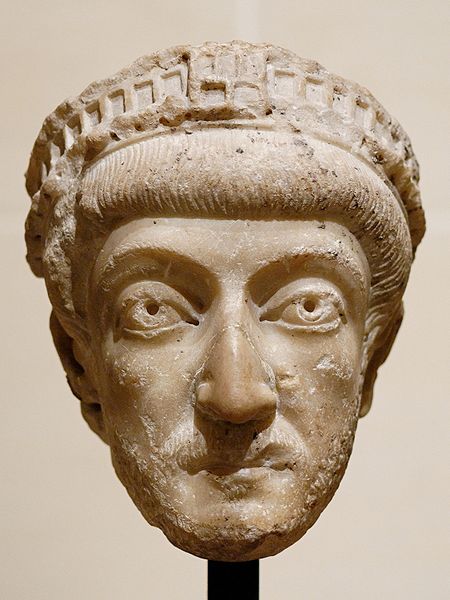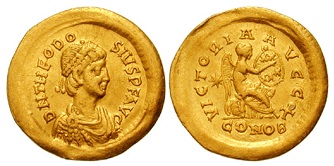<Back to Index>
- Physiologist Bernardo Alberto Houssay, 1887
- Conductor Victor de Sabata, 1892
- Emperor of the Byzantine Empire Theodosius II, 401
PAGE SPONSOR


Theodosius II (Latin: Flavius Theodosius Junior; 10 April 401 – 28 July 450), commonly surnamed Theodosius the Younger, or Theodosius the Calligrapher, was the Eastern Roman (Byzantine) Emperor from 408 to 450. He is mostly known for promulgating the Theodosian law code, and for the construction of the Theodosian Walls of Constantinople. He also presided over the outbreak of two great christological controversies, Nestorianism and Eutychianism.
Theodosius was born in 401 as the only son of Emperor Arcadius and his Frankish born wife Aelia Eudoxia. In 408, his father died and the seven year old boy became Emperor of the Eastern parts of the Roman Empire.
Government was at first by the Praetorian Prefect Anthemius, under whose supervision the Theodosian land walls of Constantinople were constructed. In 414, Theodosius' older sister Pulcheria was proclaimed Augusta and assumed the regency. By 416 Theodosius was capable of ruling himself, but his sister remained a strong influence on him. In June 421, Theodosius married Aelia Eudocia, a woman of Greek origin. The two had a daughter named Licinia Eudoxia.
Theodosius' increasing interest in Christianity, fueled by the influence of Pulcheria, had him start a war against the Sassanids (421 – 422), who were persecuting Christians; the war ended in a draw, when the Romans were forced to accept peace as the Huns menaced Constantinople.
In 423, the Western Emperor Honorius, Theodosius' uncle, died and the primicerius notariorum Joannes was proclaimed Emperor. Honorius' sister Galla Placidia and her young son Valentinian fled
to Constantinople to seek Eastern assistance and after some
deliberation in 424 Theodosius opened the war against Joannes. In May
425, Valentinian III was installed as Emperor of the West, with his
mother acting as regent. To strengthen the ties between the two parts
of the Empire, Theodosius' daughter Licinia Eudoxia was betrothed to Valentinian. In 425, Theodosius founded the University of Constantinople with
31 chairs (15 in Latin and 16 in Greek). Among subjects were law,
philosophy, medicine, arithmetic, geometry, astronomy, music and
rhetoric. In 429, Theodosius appointed a commission to collect all of the laws since the reign of Constantine I,
and create a fully formalized system of law. This plan was left
unfinished, but the work of a second commission that met in
Constantinople, assigned to collect all of the general legislations and
bring them up to date was completed, and their collection published as
the Codex Theodosianus in 438. The law code of Theodosius II, summarizing edicts promulgated
since Constantine, formed a basis for the law code of Emperor Justinian I in the following century. The Eastern Empire was also plagued by short raiding attacks by the Huns. The Huns arrived at Athyra (Büyükçekmece) in 447, but an agreement was reached with the Eastern Roman Empire, negotiated by Anatolius.
The Emperor chose to pay tribute which amounted to 350 Roman pounds
(ca. 114.5 kg) of gold until 435 and 700 Roman pounds after that. When Roman Africa fell to the Vandals in 439, both Eastern and Western Emperors sent forces to Sicily,
to launch an attack at the Vandals at Carthage, but this project
failed. Seeing the imperial borders without significant forces, the Huns and Sassanid Persia declared
war. During 443 two Roman armies were defeated and destroyed by the
Huns. In the subsequent peace agreement Roman tribute was tripled to
2,100 Roman pounds (ca. 687 kg) in gold after which the Huns
withdrew into the interior of their empire. The war with Persia on the other hand proved indecisive, and a peace was arranged in 422 without changes to the status quo. During a visit to Syria, Theodosius met the preacher Nestorius and
appointed him Patriarch of Constantinople in 428. Nestorius quickly
became involved in the disputes of two theological factions, which
differed in their Christology.
Nestorius tried to find a middle ground between those that, emphasizing
the fact that in Christ God had been born as a man, insisted on calling the Virgin Mary Theotokos ("birth-giver
of God"), and those that rejected that title because God as an eternal
being could not have been born. Nestorius suggested the title Christotokos ("birth-giver
to Christ"), but did not find acceptance by either faction and was
accused of detaching Christ's divine and human natures from each other,
a heresy later called Nestorianism. Though initially supported by the Emperor, Nestorius found a forceful opponent in Patriarch Cyril of Alexandria. With the consent of the Emperor and Pope Celestine I, an Ecumenical Council convened in Ephesus in 431, which affirmed the title Theotokos and condemned Nestorius, who was then exiled by the Emperor. Almost twenty years later, the theological dispute broke out again, this time caused by the Constantinopolitan abbot Eutyches,
whose Christology was understood by some to mingle Christ's divine and
human nature into one. Eutyches was condemned by Patriarch Flavian of Constantinople but found a powerful friend in Cyril's successor Dioscurus of Alexandria. Another council convoked to Ephesus in
449, deemed "robber synod" because of its tumultuous circumstances,
restored Eutyches and deposed Flavian, who was mistreated and died
shortly afterwards. Pope Leo I of
Rome and many other bishops protested against the outcome, but the
Emperor supported it. Only after his death in 450 would the decisions
be reversed at the Council of Chalcedon.
Theodosius died in 450 as the result of a riding accident. In the ensuing power struggle, his sister Pulcheria, who had recently returned to court, won out against the eunuch Chrysaphius. She married the general Marcian, thereby making him Emperor.